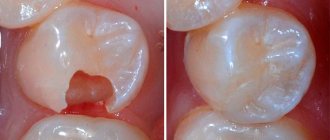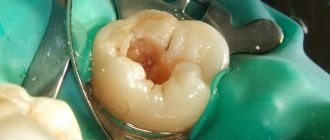Why do you need dental filling?
The first experiments with the installation of fillings were carried out before our era. Holes in the teeth were filled with resin and various mixtures. However, the archaic technique of filling teeth brought almost no positive results. Fortunately, today everything has changed dramatically. Modern fillings are successfully used to perform a variety of tasks, in particular for:
- functional filling
- aesthetic dental filling
- filling root canals
- temporary sealing of a damaged tooth
Types of dental fillings
Classic filling of carious teeth involves the installation of a dental filling without depulpation of the root canals. This technique is used for minor mechanical and carious damage to the tooth (superficial and medium caries) and is carried out in several stages.
When the dental pulp is damaged, in most cases it is necessary to fill the root canals of the teeth. In the case of milk and young molars, there are methods for preserving the functionality of the root - a biological method of treatment using calcium-containing preparations (tooth filling with calcium) or partial amputation of the pulp. This allows you to maintain the blood supply to the tooth and its vitality, which is especially important when it is in the development stage.
Depulpation involves removing the tooth root, cleaning and developing the canals with special instruments and filling them with artificial materials in order to eliminate the risk of developing inflammatory processes. There are various methods of root canal treatment. There is no absolutely ideal method, so the doctor focuses on a specific clinical case.
Stages and technology
Those barbaric times have long been forgotten when the only way to deal with a bad tooth was to remove it. Progress does not stand still, and perhaps in a few years scientists will come up with some non-contact methods for eliminating damage, however, at the moment, the main treatment for caries is dental filling. Moreover, the better the quality of the material and the more professional the doctor, the longer the damaged tooth will live.
Of course, with such an intervention in the body as filling, pain is simply inevitable, because the nerve endings located in the pulp instantly transmit a signal to the brain about the doctor’s manipulations. Even twenty years ago, dentists used painkillers only in the most extreme cases, which completely turned people away from the desire to treat caries in a timely manner. It was painful, unpleasant and terribly scary. Today, doctors at dental clinics can offer a huge range of anesthetics to choose from, thanks to which the treatment will be painless and unnoticeable.
The filling technology itself consists of several main stages and takes, on average, from half an hour to an hour:
- An injection of an anesthetic that relieves any pain.
- Thorough treatment and cleaning of areas of the tooth affected by caries. In case of pulpitis, the inflamed pulp is also removed and the tooth cavity is completely disinfected. If microscopic areas of the affected tissue remain under the filling, the inflammatory process will begin again with a vengeance.
- If the damage to the tooth surface is not very severe, a simple medical spacer is installed; otherwise, when filling teeth, the treatment technology will include the installation of pins.
- Depending on the location of the damaged tooth and other important factors, the doctor selects the material from which the filling is subsequently installed.
- In order to make sure that the work is done well, as well as that the affected areas are completely eliminated, the doctor takes an x-ray.
- The final stage of the work is grinding the filling composite to eliminate discomfort and coating the filling with indelible varnish. If the grinding is not carried out thoroughly, the patient may have problems chewing food and closing the jaw.
There are situations when the standard stages of tooth filling are not suitable for treating the affected area (canal curvature, filling with a pin and inlay, resection of the root apex). In such cases, so-called retrograde filling is used to prevent further inflammation and hermetically close the canals.
Dental filling methods
All methods of filling teeth are based on the use of various materials, which have their own advantages and disadvantages. Therefore, when choosing a technology, the doctor focuses on the individual characteristics of the structure of the root canals and the patient’s body as a whole.
Filling teeth with gutta-percha
Removal of the nerve of the tooth and filling of the canals, when the cavity is filled with a special paste based on gutta-percha with the addition of various impurities. Despite its simplicity and relatively low cost, this method of filling teeth cannot be called reliable and safe. It is often accompanied by a violation of tightness, the development of inflammation and allergic reactions.
Using a pin
Filling a pulpless tooth with pins is one of the most common techniques in dentistry. There are two types of pins (fillers): gutta-percha and metal. Filling tooth canals with gutta-percha is considered a more reliable and safe method. Even taking into account the presence of polymers, dyes and metal salts, such pins are biocompatible and do not cause allergies. Silver metal structures have good flexibility and can be installed in long and curved channels, however, silver is prone to oxidation, which can lead to inflammation. Titanium posts are better in terms of tissue compatibility, but they are very rigid and require the preparation of a special bed, which makes the tooth walls extremely fragile.
Sealers-sealers
Even gutta-percha pins for filling the root canals of teeth by themselves are not able to provide a reliable result, since they do not have antibacterial properties. To improve the quality of filling, dentists use sealers - sealants that ensure a tight fit of the material to the canal walls. There are natural (based on cement, zinc oxide, etc.), polymer sealers, glass ionomer cements and pastes based on calcium hydroxide.
What are they?
When sealing a tooth, both permanent and temporary fillings can be performed. Their composition is significantly different, since the purpose is completely different. Below we will consider what the main differences between these fillings are.
- Temporary. Used as a component of a tooth with short-term wear. After a certain time, it is removed and replaced with a permanent one. Used for therapeutic and diagnostic purposes. In most cases, temporary is used to prevent the release of medications that are placed into the tooth cavity for treatment. A temporary filling is also often used to close canals and arsenic. Any dentist can do this.
- Constant. Acts as a permanent element of the tooth, which can remain in it for several years. The composition of the constant varies depending on its type.
Temporary and permanent fillings
There are several types of permanent fillings. Their differences vary depending on the type of specialized material used. The main ones include:
- metal - made from special metal alloys that contain mercury;
- cement - consist of different types of cement: phosphates, glass ionomers and others;
- plastic - created on the basis of acrylic acid compounds;
- light polymer - also called photopolymers, which harden when exposed to ultraviolet light.
The choice depends on the condition of the tooth and the desired result.
Teeth filling process
- Initial consultation, taking x-rays.
- Coordination of treatment methods and selection of the type of fillings to be installed.
- Anesthesia before therapeutic intervention (local anesthesia, sedation, in rare cases - general anesthesia).
- Preparation of damaged or caries-affected tooth tissues.
- Grinding and processing the surface of the filling for proper closure.
Filling temporary teeth (baby teeth) follows the same plan, however, in pediatric dentistry, more compatible and safe materials are used.
Filling of anterior teeth
In the case of front teeth, the aesthetic aspect comes to the fore, so the filling material must have the appropriate properties. Although the front teeth receive better hygiene due to their accessibility, they are also susceptible to caries. Installing a filling on the front teeth is considered a more complex procedure: it is necessary not only to give the filling the desired shape, but also to choose the right color. In most cases, filling of anterior teeth is carried out using compomers, as well as light composite fillings, which harden under the influence of ultraviolet radiation. Be that as it may, in case of serious damage, it is impossible to achieve good aesthetics with the help of filling, so you often have to turn to orthopedic solutions.
Questions patients often ask:
Who whitens teeth?
If you want to whiten your teeth and don’t know, contact a dentist - in most clinics they do this. In large centers with high traffic, it is possible to hire a separate specialist: a dental hygienist who specializes in professional teeth cleaning or whitening.
A molar tooth is loose - who should I run to?
If your teeth have become loose as a result of an impact or injury, do not hesitate - your periodontist will perform splinting and give your teeth a chance to strengthen.
Bad breath - who can help?
First, see a therapist. If your bad breath is related to dental or gum disease, it will tell you what to do next.
One or more teeth are missing – should you see an implantologist, surgeon or orthopedist?
To an orthopedist. Unlike an implantologist, he will offer several options for restoring the dentition, both with and without the use of implants. Contact an implantologist only if you are 100% sure that you want to get an implant.
I have a toothache – which specialist can help?
Either a therapist or a surgeon will help. In most clinics, therapists are trained to remove teeth if necessary, so the best option is a general dentist.
Installing a seal on a pin
More recently, it has become common practice in dentistry to install a filling on a post if the tooth is more than 50% destroyed. Thus, the technique made it possible to avoid prosthetics. Filling a tooth with a pin must be preceded by removal of the nerve. Then a special screw is inserted into the root canal and fixed with cement. The procedure is completed by layer-by-layer application of light-polymer composite materials. However, installing a pin does not guarantee reliability and safety. Over time, the cement breaks down, causing microbes to get under the filling, causing the formation of caries. Having chosen modern dentistry to install a filling, you are unlikely to encounter such technology.
Fillings for baby teeth
Fillings for baby teeth.
Photo from the site: zublandia.com Many parents are interested in the question: Do they put fillings on a patient’s baby teeth? In childhood, teeth also tend to hurt, succumb to caries and decay. Even if others grow up in their place, they must be treated. Why is it so necessary to put fillings on baby teeth?
Fillings are the best and most reliable way to protect a small child’s temporary teeth. Parents have no reason to worry that their children will get stressed when they see a burr machine, because today the filling process is carried out at a high-tech level, and modern fillings will reliably protect temporary teeth.
When examining the oral cavity, the doctor will prescribe the necessary treatment based on the child’s age and the condition of his teeth. Today, more than one type of procedure is used in pediatric dental treatment. Most often this is coating with various compounds, including silver, or installing fillings.
Only a pediatric dentist has the right to carry out such treatment.
What material
The choice of material for fillings for children is the most difficult in the process of children's dental treatment. And only an experienced and qualified doctor can select the appropriate material. And in this choice, much will depend on the child’s age , his dental condition and other factors. But the main problem is their limitations:
- Cement fillings have many disadvantages: a long installation procedure, curing and low strength.
- Composite materials often have to be abandoned due to their poor quality.
- Whenever possible, people try not to install light and photopolymer fillings, due to their negative effects if installed incorrectly.
- And only glass ionomer cement has a combination of all properties suitable for the treatment of children’s teeth, and it is currently used
- Colored compomer is also a good choice because its properties are soft, plastic and easy to use.
Types of filling materials
| Material type | Varieties | Description |
| Cement | – Zinc phosphate – Silicate – Glass ionomer | Currently, of all types of cement fillings, only glass ionomer fillings are actively used, since they provide good mechanical and chemical bonding with tooth tissues. Zinc-phosphate fillings tend to shrink, so they are almost never used when filling teeth for caries. Silicate materials are considered toxic and also have restrictions in their use. |
| Metal | – Gold – Copper – Silver | They are distinguished by high quality and a very large margin of safety. On the other hand, amalgam fillings shrink over time and are not always airtight, which can lead to the development of secondary caries. Due to low aesthetic indicators, they are used for filling chewing teeth. |
| Composite materials | – Acrylic – Epoxy – Light-curing – Chemical-curing | Composite fillings are obtained by mixing organic and inorganic elements. Due to the noticeable disadvantages of filling teeth with composite materials (rapid wear and toxicity for acrylic ones, fragility for epoxy ones), the first two types of fillings are practically not used. Light-curing composites are considered the best: they quickly harden under the influence of ultraviolet radiation and can be used in any part of the jaw. The procedure is often called light dental filling. |
| Compomer | It is a kind of hybrid of glass ionomer and composite | Very aesthetic and high-quality fillings, which are most often used in the frontal region when restoring teeth after chips. Their only drawback is fragility. |
| Materials for temporary fillings | – Artificial dentin – Soft dentin paste – Cariosan (cement) – Vinoxol (zinc oxide based) | They are often placed during pulpitis to check the reaction of the tooth, as well as after filling root canals until a permanent filling is installed. Temporary fillings are also used when filling a tooth under a crown. |
Types of fillings
Nowadays, dentistry uses many different materials from which fillings are prepared. They can be permanent or temporary. A permanent filling is installed for minor damage to the tooth, and a temporary filling is used for long-term treatment , for example, when a healing composition is placed under the tooth. The material used for making fillings is as follows:
- cement and silicate;
- plastic;
- metal, amalgam;
- ceramics;
- composites.
Depending on the type of material used, fillings are:
- cement;
- composite;
- compomer.
There are other types of fillings made for dental purposes - plastic, metal and ceramic.
What material
Of all the varieties, fillings made from reflective composite are considered to last the longest in service . They are distinguished not only by their high cost, but also by their long service life. Such fillings not only look elegant, but are also able to change their shade when the lighting changes.
A popular material is cement. To this day, fillings made from this material are in considerable demand due to their low cost, taking into account the good properties of adhesion and strength.
When choosing which material to use for a filling, you must remember that they all have their own characteristics, advantages and disadvantages. When choosing, you will proceed from the capabilities of your wallet and the location where the tooth is located - in the back of the mouth, in the molar or in the front.
How much does the procedure cost?
The exact cost of dental filling is usually announced by the doctor at the initial consultation. The price will depend on the filling material used and the amount of work. Filling canals will cost more than simply installing a filling.
| Type of filling | Price |
| Cement filling | From 900 rubles |
| Glass ionomer filling | From 1,500 rubles |
| Filling made from a light-curing composite of the latest generation | From 3,500 rubles |
| Filling made from a chemocurable composite of the latest generation | From 2,500 rubles |
Plastics and composites
An extensive group that includes:
- Acrylic-containing plastics. They are resistant to abrasion, but at the same time porous and quite toxic, so they have been used less and less in recent years.
- Composites with epoxy resins (chemically cured). Slightly better than plastic, but quite fragile and darken a few years after installation.
- Light-curing composites (photopolymers). Strong, reliable and durable. They polymerize and harden under the influence of ultraviolet radiation. The composition of a photopolymer tooth filling includes porcelain, which gives the material strength and aesthetics. The most popular option today.








